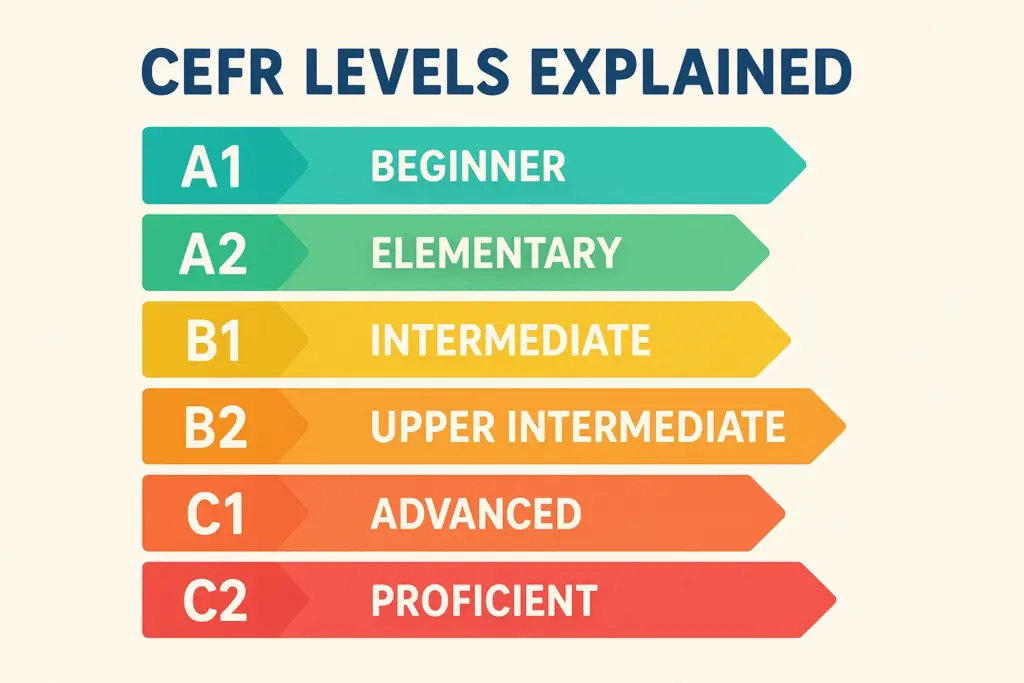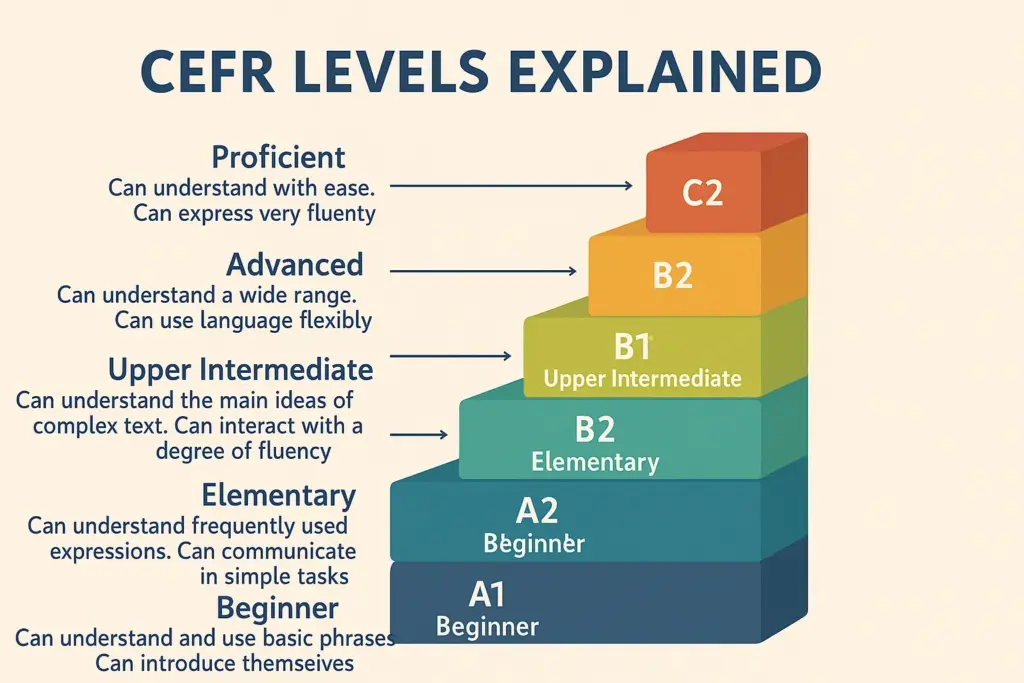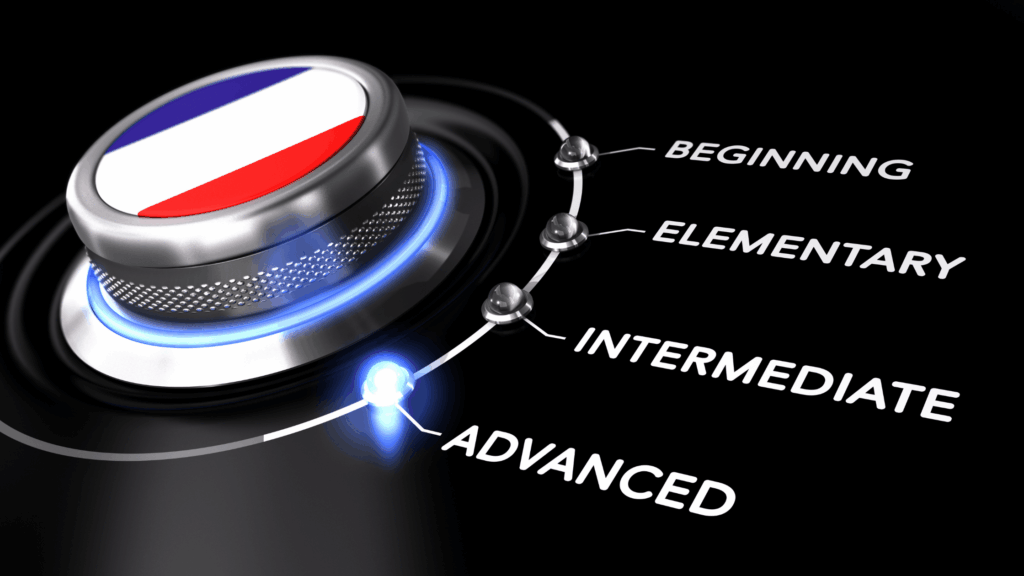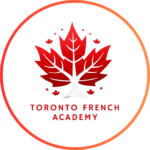
Understanding the CEFR: What Do A1, A2, B1, and B2 Levels Mean?
If you’re learning a new language—especially French—you’ve probably encountered terms like A1, B2, or “intermediate level.” These aren’t just random designations. They’re part of a standardized international framework called the Common European Framework of Reference for Languages, or CEFR for short.
In this comprehensive guide, you’ll find the CEFR levels explained in detail—what each level means, what you can do at each stage, and how to use this system to track your progress, prepare for exams like TEF or DELF, and reach your language learning goals.
 What Is the CEFR?
What Is the CEFR?
The CEFR is an internationally recognized system used to describe language proficiency. Originally developed by the Council of Europe, it provides a common basis for describing the skills needed to communicate effectively in a foreign language.
This framework is now widely used across Europe and around the world in schools, universities, immigration systems, and language testing programs (like TEF, TCF, IELTS, and more).
In this post, we’ll focus on CEFR levels explained from A1 to B2, which cover beginner to upper-intermediate learners. These are the most commonly tested and required levels for practical use and certification.
 The 6 CEFR Levels at a Glance
The 6 CEFR Levels at a Glance
| Level | Description | User Type |
|---|---|---|
| A1 | Beginner | Basic User |
| A2 | Elementary | Basic User |
| B1 | Intermediate | Independent User |
| B2 | Upper Intermediate | Independent User |
| C1 | Advanced | Proficient User |
| C2 | Mastery | Proficient User |
While C1 and C2 are ideal long-term goals for fluency, A1 to B2 are where most learners spend their time—and where most certifications focus.
Let’s look at the CEFR levels explained in depth from A1 to B2.
 A1 – Beginner (Breakthrough Level)
A1 – Beginner (Breakthrough Level)
This is the absolute starting point for language learners.
At A1, you’re learning the building blocks of the language: the alphabet, basic vocabulary, and simple sentence structure.
 What You Can Do at A1:
What You Can Do at A1:
Introduce yourself and others
Ask and answer simple personal questions (e.g., age, nationality, job)
Use everyday phrases like greetings and farewells
Understand slow, clear speech with repetition
 Example:
Example:
“Je m’appelle Marie. Je suis étudiante. J’habite à Brampton.”
 Who This Level Is For:
Who This Level Is For:
Complete beginners
Learners just starting a French course
Anyone preparing for DELF A1 or an immigration language requirement at the basic level
At A1, communication is limited, but it’s the essential foundation for your future progress.
 A2 – Elementary (Waystage Level)
A2 – Elementary (Waystage Level)
The A2 level builds on what you learned at A1. You’re still dealing with simple situations but with more vocabulary and functional grammar.
 What You Can Do at A2:
What You Can Do at A2:
Talk about your routine, work, shopping, or family
Describe basic needs and immediate environments
Understand frequently used expressions related to areas of immediate relevance
Interact in simple conversations if the other person speaks slowly
 Example:
Example:
“Je travaille dans un restaurant. Je commence à 9 heures et je finis à 17 heures.”
 Who This Level Is For:
Who This Level Is For:
Learners with some experience (3–6 months of study)
Candidates preparing for the DELF A2 exam
People who want to travel or live short-term in a French-speaking country
At this stage, you’re gaining the ability to survive in French—ordering food, asking for directions, and handling simple conversations.
 B1 – Intermediate (Threshold Level)
B1 – Intermediate (Threshold Level)
Reaching B1 means you’ve become an independent user. You can handle more complex interactions and are starting to think in the language.
 What You Can Do at B1:
What You Can Do at B1:
Understand the main points of spoken and written texts on familiar topics
Deal with most travel situations without major issues
Write short connected texts on personal interests or experiences
Describe events, opinions, and plans
 Example:
Example:
“L’année dernière, j’ai voyagé en France. C’était une expérience incroyable. J’ai parlé avec beaucoup de gens et j’ai amélioré mon français.”
 Who This Level Is For:
Who This Level Is For:
Learners who’ve studied French for about 1 year or more
TEF or DELF B1 exam candidates
Students or professionals preparing to live abroad
This is a major milestone where your communication becomes functional and fluent in everyday situations.
 B2 – Upper Intermediate (Vantage Level)
B2 – Upper Intermediate (Vantage Level)
The B2 level is the benchmark for academic, professional, and immigration-related use of French. It represents strong language skills and comfort with abstract topics.
 What You Can Do at B2:
What You Can Do at B2:
Understand the main ideas of complex texts, including technical discussions
Interact with a degree of fluency and spontaneity
Express opinions clearly in speech and writing
Write essays or reports on various subjects
 Example:
Example:
“À mon avis, parler plusieurs langues est un atout majeur dans le monde professionnel. Cela montre la capacité d’adaptation et favorise les opportunités.”
 Who This Level Is For:
Who This Level Is For:
Those applying for Canadian PR (CLB 7–9 = B2)
Students pursuing higher education in French-speaking countries
Professionals working in international or bilingual environments
B2 is where language learning starts to become a powerful career and immigration tool.
 Why It Helps to Have the CEFR Levels Explained
Why It Helps to Have the CEFR Levels Explained
Understanding where you stand—and where you’re going—lets you:
Set realistic goals (e.g., “I want to move from A2 to B1 in 6 months”)
Choose the right learning resources based on your current level
Prepare effectively for language tests like TEF, DELF, or TCF
Track progress in a measurable, globally accepted way
Meet official requirements for study, work, or immigration
 How Can You Know Your CEFR Level?
How Can You Know Your CEFR Level?
Not sure where you fall on the scale? Here’s how to find out:
Take an online placement test (many free tools available)
Ask a certified teacher for an assessment
Compare your skills with CEFR can-do statements
Try TEF or DELF sample exams
Tip: If you’re preparing for TEF Canada or DELF, most immigration processes will look for B1 or B2 levels.
 The CEFR Levels Explained for French Exams
The CEFR Levels Explained for French Exams
| CEFR Level | TEF Canada | DELF | CLB (Canadian Level Benchmark) |
|---|---|---|---|
| A1 | N/A | DELF A1 | CLB 2–3 |
| A2 | N/A | DELF A2 | CLB 3–4 |
| B1 | TEF Level 4 | DELF B1 | CLB 5–6 |
| B2 | TEF Level 5–6 | DELF B2 | CLB 7–9 |
 How Long Does It Take to Progress Through CEFR Levels?
How Long Does It Take to Progress Through CEFR Levels?
Many learners wonder how long it takes to move from A1 to B2. While the answer depends on your time, motivation, and exposure to the language, here’s a rough estimate based on average study hours:
| CEFR Level | Approximate Study Hours |
|---|---|
| A1 | 60–100 hours |
| A2 | 100–150 hours |
| B1 | 200–250 hours |
| B2 | 300–400 hours |
If you study consistently for 1 hour per day, you could expect to reach B2 in about 12–18 months. However, immersion, speaking practice, and quality of study can significantly reduce this timeline.
When you have the CEFR levels explained clearly, it’s easier to create a realistic study plan and stay motivated.
 Practical Tips for Moving Up the CEFR Ladder
Practical Tips for Moving Up the CEFR Ladder
To move effectively from one level to the next, use these strategies:
1. Balance All Four Skills
Focus on reading, writing, listening, and speaking. Many learners only read or memorize vocabulary—don’t neglect speaking and listening!
2. Use Can-Do Statements
The CEFR includes “can-do” descriptors for each level. For example:
A2: I can describe my family and job using simple language.
B2: I can present clear arguments for or against a point of view.
These benchmarks help you track practical progress, not just grammar points.
3. Immerse Daily (Even a Little Bit)
Watch French YouTube channels, listen to French podcasts, label items around your home, or talk to yourself in French. Small daily efforts compound over time.
4. Test Yourself Often
Use free online quizzes, apps like Duolingo/Busuu, or take practice TEF/DELF exams. Testing reveals your weak spots and helps you solidify what you’ve learned.
By using these techniques and having the CEFR levels explained as a roadmap, you’re much more likely to reach your goals.
 Final Thoughts: Mastering French with the CEFR Levels Explained
Final Thoughts: Mastering French with the CEFR Levels Explained
With the CEFR levels explained, you’re no longer learning in the dark. These levels give you a clear map—from beginner to fluent—and help you focus your energy where it matters most.
Whether you’re starting from zero or aiming for B2 for Canadian immigration, understanding your CEFR level gives you:



 Next Steps
Next Steps
Take a CEFR-level placement quiz online
Download our CEFR checklist PDF
Book a TEF preparation class tailored to your level
Join our French learners’ WhatsApp group for daily practice

❓ FAQ – CEFR Levels Explained
Q1: What’s the difference between B1 and B2?
B1 means you’re conversational—you can handle travel, personal discussions, and basic work topics.
B2 is more academic or professional—you can debate, write formal texts, and interact fluently with native speakers.
Q2: Is B2 level fluent?
Not quite. B2 is often described as “independent fluency.” You can function well in daily life and work situations but may still struggle with complex or abstract language. True fluency usually begins at C1.
Q3: Which CEFR level is required for Canadian PR (TEF)?
For TEF Canada, most Express Entry applicants aim for CLB 7–9, which corresponds to B2 level proficiency in French.
Q4: Can I skip a level, like from A2 to B2?
It’s possible, but not recommended. Each CEFR level builds important foundations. Skipping levels may leave you with gaps in grammar, comprehension, or fluency.
Q5: Do CEFR levels apply only to French?
No. The CEFR applies to all major languages—Spanish, German, English, Italian, etc. It’s a universal standard for measuring language ability.
📌 Conclusion: Why CEFR Levels Matter
With the CEFR levels explained clearly, your language learning becomes more strategic and structured. You’ll be able to:
Set appropriate goals
Track your growth
Choose resources that match your current level
Understand your strengths and weaknesses
Pass required exams like TEF and DELF
No matter where you start, the CEFR gives you the clarity to keep going.
🎯 Ready to Take Action?
If you’re unsure of your level or want to boost your TEF preparation:
📞 Book a Free Level Assessment with a Tutor
🎓 Download a CEFR Self-Study Roadmap
💬 Join a French Learners WhatsApp Group
📝 Start a Level-Based Learning Plan (A1 to B2)
Trusted Resources for French Learners


 What Is the CEFR?
What Is the CEFR? The 6 CEFR Levels at a Glance
The 6 CEFR Levels at a Glance A1 – Beginner (Breakthrough Level)
A1 – Beginner (Breakthrough Level) Example:
Example: Who This Level Is For:
Who This Level Is For: A2 – Elementary (Waystage Level)
A2 – Elementary (Waystage Level) B1 – Intermediate (Threshold Level)
B1 – Intermediate (Threshold Level) B2 – Upper Intermediate (Vantage Level)
B2 – Upper Intermediate (Vantage Level) Why It Helps to Have the CEFR Levels Explained
Why It Helps to Have the CEFR Levels Explained Set realistic goals (e.g., “I want to move from A2 to B1 in 6 months”)
Set realistic goals (e.g., “I want to move from A2 to B1 in 6 months”) Choose the right learning resources based on your current level
Choose the right learning resources based on your current level Track progress in a measurable, globally accepted way
Track progress in a measurable, globally accepted way Meet official requirements for study, work, or immigration
Meet official requirements for study, work, or immigration How Can You Know Your CEFR Level?
How Can You Know Your CEFR Level? How Long Does It Take to Progress Through CEFR Levels?
How Long Does It Take to Progress Through CEFR Levels? Next Steps
Next Steps Book a TEF preparation class tailored to your level
Book a TEF preparation class tailored to your level Join our French learners’ WhatsApp group for daily practice
Join our French learners’ WhatsApp group for daily practice